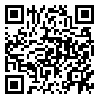Volume 7, Issue 3 (11-2020)
NBR 2020, 7(3): 315-321 |
Back to browse issues page
Download citation:
BibTeX | RIS | EndNote | Medlars | ProCite | Reference Manager | RefWorks
Send citation to:



BibTeX | RIS | EndNote | Medlars | ProCite | Reference Manager | RefWorks
Send citation to:
Esmaeilnejad B, Gharekhani J, Samiei A, Rezaei H. Molecular detection of Coxiella burnetii in ticks isolated from goats of Meshkin-Shahr County, Ardabil Province, Iran. NBR 2020; 7 (3) :315-321
URL: http://nbr.khu.ac.ir/article-1-3126-en.html
URL: http://nbr.khu.ac.ir/article-1-3126-en.html
, b_esmaeilnejad@yahoo.com
Abstract: (6510 Views)
Q fever is caused by Coxiella burnetii and is transmitted by more than 40 tick species. This study aimed to identify the tick species in goats of Meshkin-Shahr, Ardabil Province, Iran, and their role in the transmission of C. burnetii. A number of 365 goats were inspected for the infestation of hard ticks in a randomized sampling design, during a 1-year period from April 2013 to April 2014. A total number of 280 tick specimens were collected and identified and were then examined by molecular methods for the presence of C. burnetii infection. 40.8% of the infected animals had at least one species of tick. The goats which were studied were found to be infested by the following tick species: Hyalomma anatolicum anatolicum (33.9%), Rhipicephalus sanguineus (22.1%), Rhipicephalus turanicus (17.1%), Hyalomma excavatum (11.1%), Rhipicephalus bursa (5%), Hyalomma detritum (3.9%), Hyalomma dromedarii (3.6%), Hyalomma asiaticum asiaticum (1.8%), and Hyalomma marginatum (1%). There were no significant differences between the infestation rate in different seasons, genders and ages of the animals which were studied (p=0.05). The molecular assay of 280 tick specimens revealed the presence of C. burnetii infection in 5 out of 40 pool samples (6-8 tick individuals of the same species in each pool), including H. anatolicum anatolicum (3 pools), H. excavatum (1 pool) and R. sanguineus (1 pool). The present study, therefore, reports the rate of C. burnetii infection transmitted by hard ticks in North-West of Iran for the first time. According to the zoonotic aspect of Q fever, further studies on the carriers as well as other hosts of the infection were found to be necessary.
Type of Study: Original Article |
Subject:
Microbiology
Received: 2018/05/13 | Revised: 2020/11/29 | Accepted: 2020/06/9 | Published: 2020/11/21 | ePublished: 2020/11/21
Received: 2018/05/13 | Revised: 2020/11/29 | Accepted: 2020/06/9 | Published: 2020/11/21 | ePublished: 2020/11/21
Send email to the article author
| Rights and permissions | |
 |
This work is licensed under a Creative Commons Attribution-NonCommercial 4.0 International License. |







